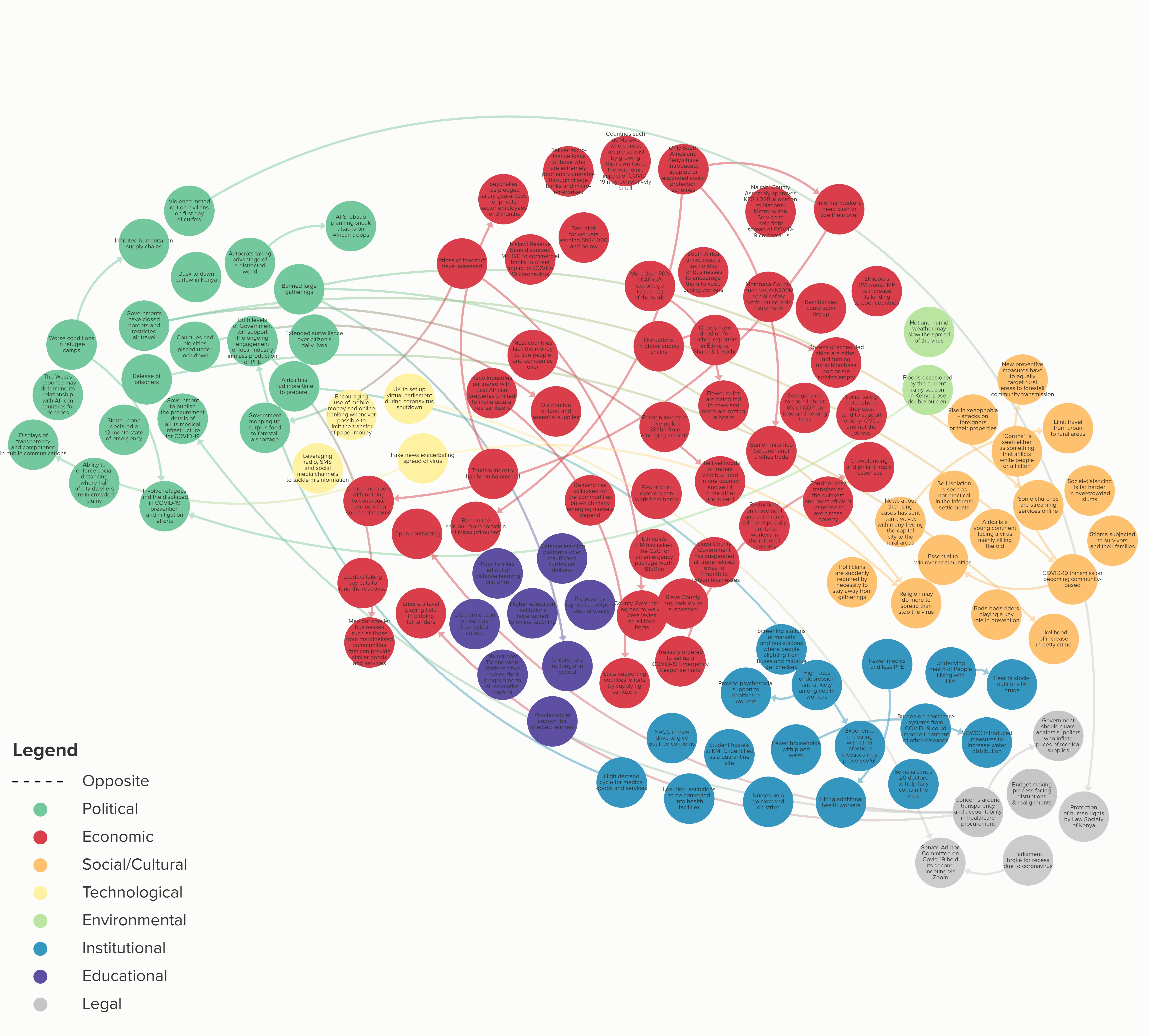The UNDP Accelerator Lab in Kenya compiled a systems map showing the interrelations between effects of and responses to the COVID-19 pandemic, grouped under categories as Political, Economic, Social, Technological, Environmental, Educational, Legal and Institutional forces (Photo: UNDP Kenya)
The speed at which COVID-19 is moving since its emergence in December 2019 – with just under 2 million reported cases worldwide at the time of writing and the latest figures here – has necessitated urgency and innovation from all of us engaged in combatting it. Countries and institutions across the globe are spending trillions of dollars to mitigate the grave health, social and economic crises which the novel coronavirus pandemic has induced. However, as we collectively work to respond to this emergency of unprecedented scope, we can also keep in mind that innovations born of necessity during this time have the potential to strengthen our socioeconomic infrastructures for the future.
A practical example is the disruption of COVID-19 on global supply chains and increased market pressures, which have led to a move to increase local/domestic production of key goods, particularly medical devices. In Kenya, in the wake of the spread of COVID-19 the Kenya Bureau of Standards placed a temporary ban on the importation of second-hand clothes, and the Government is looking to revive the local textile industry: according to the State, activating operations at Rivatex in Eldoret, Kicomi in Kisumu and the Nanyuki-based Mount Kenya Textiles (Mountex) could create 1.3 million additional jobs. Upscaling local production in the long-term would not only be a tool for inclusive growth, but also a weapon in the fight against climate change if intercontinental transport is reduced – as striking satellite images of reductions in carbon emissions since the onset of COVID-19 lockdowns and travel restrictions suggest.
Mapping systems of potential and actioned innovation to respond to COVID-19
Responding to the speed, dynamics and complexity of the negative developmental impact of COVID-19 fits the UNDP’s Accelerator Labs' foundational goals. By building a system map, we in Kenya have attempted to understand the systemic nature of the virus by identifying its structure and looking for positive changes which have either been raised as potential solutions or already come about as innovations to the virus – which we can consider as #coviddividends.
Methodologically, we began by casting our net wide to illuminate forces that impact how the response to COVID-19 was evolving by drawing on data and stories from social media, including twitter analytics and trending hashtags, and also tapped into the work of Dataminr and media outlets. The factors we considered included people, trends, events, norms, beliefs, phenomena, institutions, laws and policies, focusing on those that led to both negative and positive systemic behaviors and grouping these within defined Political, Economic, Social, Technological, Educational, Legal, and Institutional spheres.
A sample from the systems map showing Political, Technological and Economic forces related to the effects of and response to COVID-19 (Photo: UNDP Kenya)
Below are a few examples of what we could consider are potential or actioned #coviddividends that have arisen from the systems mapping exercise:
Realignment of the budget-making process:
Travel restrictions and social distancing requirements announced by the Ministry of Health have halted physical public participation processes, which are normally required before budgets are approved [1]. Adapting to the current circumstances, the public could be asked to submit written memoranda for consideration: this would be an opportunity to enhance the effectiveness of public participation exercises by ensuring that a good number of citizens can present their views.
Crowdsourcing platforms and other engagements such as interactive, targeted and measurable SMS campaigns and surveys could enhance public participation in the era of social distancing. According to a Sector Statistics Report covering July – September 2019, Kenya’s mobile penetration stands at 112 percent: the report released by the Communications Authority of Kenya (CA) shows mobile subscriptions are on the upward trajectory, standing at 53.2 million. The high mobile penetration and connectivity rates across the country allow for leveraging of telecoms data as a tool to gather real-time data for informed decision-making.
Transparency and accountability:
Citizens have voiced concerns around transparency and accountability in healthcare procurement; financial management considering the colossal amount of money being channeled towards fighting the pandemic and the resultant duplication of efforts/resources. Equal focus could and should be placed on developing open contracting platforms; supporting government to publish the procurement details of all its medical infrastructure and new forms of social accountability to increase public voice and participation in the process of accountability.
Access to formal justice system:
The Judiciary scaled down its operations and has been virtually providing essential services to ensure delivery of justice is not completely disrupted: one court even handled 57 matters in a virtual session to mitigate covid-19 disruptions. The crisis could act as a tipping point to encourage the judiciary and other arms of government to rethink their approach to technology and to see how it can be used to provide a more engaging and inclusive experience for their stakeholders.
Leaders from across countries and sectors ought to consider opportunities afforded by innovations to tackle the pandemic, as these have the potential to transform short-term emergency efforts into sustainable systemic changes. The UNDP Accelerator Lab in Kenya is currently mapping and analyzing response efforts to the crisis to see where we can streamline further going forward and take innovative thinking to tackle COVID-19 into the longer-term.
Authored by Victor Apollo, Head of Solutions Mapping – UNDP Accelerator Lab Kenya
************************************************************************************************************************
[1] The public finance framework under Articles 201, 221, and 232 requires that public participation be integrated in the budget process. This is best expounded in the Public Finance Management Act, 2012 and the National Assembly Standing Orders.

 Locations
Locations